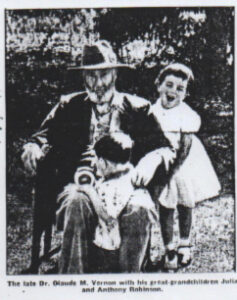www.christinenicholls.co.uk
www.europeansineastafrica.co.uk
Born in 1866 in Leyton, Sussex, Claude Vernon aspired to be a doctor. After training in London and Cambridge he landed a job as Medical Officer of Health in Ashford, Kent, where he stayed until 1913. After the First World War he decided to move to Kenya in 1920 with his growing family – wife Edith Augusta and children Maurice, Joan and Nancy. His adventures began. In Nairobi he met the Hon. Berkeley Cole, Legislative Council representative for Nanyuki, who told him that the town needed a doctor. The prospect was enticing, because the job went with a farm which had been allocated to a doctor who never arrived. After a stint in Nyeri waiting for formalities to be completed, the family travelled to Nanyuki to find the 2,000 acre farm they had been given.
It was depressing – utterly undeveloped, covered in oat grass and cedar and with no living accommodation. As his training had not equipped him to build a house, Vernon engaged the son of a neighbouring farmer to construct a simple mud and wattle dwelling while the family lived in a tent. He trained himself to be a carpenter to make furniture out of the wooden boxes that held petrol tins. The family grew their own vegetables. Fortunately Vernon had shot at Bisley before leaving England, so he was able efficiently to provide buck meat for the pot. He named his farm Simba Shamba because the roar of lions could be heard every night.
He set up his practice in Nanyuki, although the farm was thirteen miles distant and entailed crossing five rivers. In the rains it was easier to travel by mule buggy, although when he often had to go as far as Isiolo or Embu he would attempt the mud roads by car.
These early doctors had to be prepared to travel miles to their patients, in all weathers. The most common ailment was malaria, but traumatic accidents ran a close second. Smallpox, plague and leprosy were endemic but did not trouble the European population. However, syphilis and intestinal parasites were no respecters of colour. Typhoid fever and paratyphoid were fairly common, and amoebic dysentery very common. Tropical ulcers had to be treated, as did tick typhus. Then there were the babies to deliver on remote farms. It was an arduous life, but the doctors never refused to come when they were called, even Dr Charles Caddick of Sotik, who was stymied by a patient with acute appendicitis on whom he couldn’t operate because he had lost two fingers of his right hand in the Boer War.
After six years Vernon decided to leave Nanyuki when his practice did not pay, and he moved to Limuru. The early experience of helping to construct his home on the farm now enabled him to build a timber house, which was soon surrounded with an attractive garden frequented by other gardeners. There was a further move, to Mombasa, where Vernon continued to practice until the age of eighty.

Dr Vernon with his great grandchildren.
Finally, on retirement after the Second World War, he moved to Naivasha and later to Kitale to be with his son Maurice, and finally he moved back to Limuru. Vernon died at Limuru in 1959 at the age of ninety-four, and his wife Edith followed in 1963 at the age of ninety-seven. Both are buried in Langata cemetery, Nairobi.
[With thanks to Nick Chater for providing much of the information.]

Recent Comments